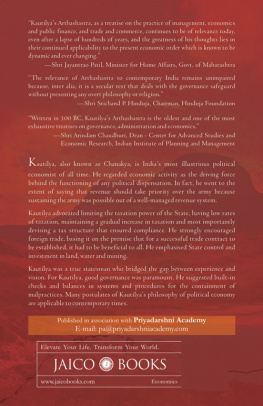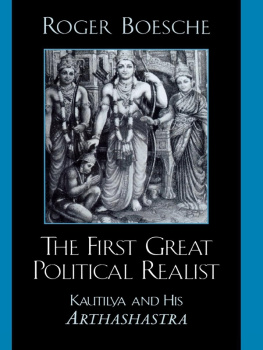KAUTILYA'S ARTHASHASTRA
The Way of Financial Management
and Economic Governance
JAICO PUBLISHING HOUSE
Ahmedabad Bangalore Bhopal Bhubaneswar Chennai
Delhi Hyderabad Kolkata Lucknow Mumbai
Published by Jaico Publishing House
A-2 Jash Chambers, 7-A Sir Phirozshah Mehta Road
Fort, Mumbai - 400 001
www.jaicobooks.com
Priyadarshni Academy
1, Arcadia, Ground Floor, Nariman Point, Mumbai 400 021. INDIA
Tel.: +91 (22) 2204 9398, 2204 9315
Website: www.priyadarshniacademy.in
E-mail:
KAUTILYA'S ARTHASHASTRA
ISBN 978-81-8495-029-8
First Jaico Impression: 2009
Sixth Jaico Impression: 2012
No part of this book may be reproduced or utilized in
any form or by any means, electronic or
mechanical including photocopying, recording or by any
information storage and retrieval system,
without permission in writing from the publishers.
Printed by
Rashmi Graphics
#3, Amrutwel CHS Ltd., C.S. #50/74
Ganesh Galli, Lalbaug, Mumbai-400 012
E-mail:
This book is dedicated to the Memory of
Late Shri BHAGWANDAS PERAJ THAKKER
Global Insurance Services Pvt. Ltd.
Regd. & Head Office: Gresham Assurance House,
4th Floor, Sir P. M. Road, Fort,
Mumbai-400 001, India.
FOREWORD
Jignesh Shah
Chairman, Promotion of Oriental Studies Committee, Priyadarshni Academy
Chairman & Group CEO, Financial Technologies Group
N o book perhaps deserves to have as much pride of place in the personal libraries of political pundits, social scientists, and economic scholars as Arthashastra, written by Kautilya (also known as Chanakya or Vishnugupt) as far back as 300 BCE. Not only was Kautilya a man of letters and a shrewd statesman, but he also had profound knowledge of political science, military strategy, and economics. He was the best known professor of politics and economics at the world renowned Takshashila Gurukul (university) in ancient India. He was the advisor to the first Maurya king, Chandragupta, and later became the Prime Minister of his kingdom.
Arthashastra may literally mean 'Science of Money', although it is also defined as a political science, science of political economy, or science of material gain or profit. Leaving aside the meaning of the word itself, Kautilya's Arthashastra is undoubtedly an excellent treatise on statecraft, economic policy, and military strategy, and provides an outline of legal and administrative structure for governing a political economy. Be that as it may, it is in reality a discourse on the administration of finances through raising revenues from different sources, economic or otherwise, and expending the same on maintaining law and order, defence of the state and social welfare, as also for regulating economic, social and other activities of the citizens by the State.
Arthashastra is, therefore, addressed more to the rulers than their subjects, though the latter too gain much knowledge of the various economic, political, and social practices prevailing during Chandragupta Maurya's times. Yet, Arthashastra is more than mere economic history. Many of its tenets are as much valid today to the governments as well as the populace in their day-to-day affairs as during the Mauryan era.
Since the State raises finances from all the sectors of the economy, namely, agriculture and forestry, livestock and dairy farming, export-import and domestic trade, industry and crafts, and services of diverse hues, Kautilya has discussed all these economic activities, defined their objectives, and even drawn rules for administering such activities to the benefit of the society as well as for earning revenues for the State. Not only has he prescribed varying fees and charges for engaging in different activities, but even provided elaborate fees and penalties for violations of the rules to prevent abuses, which at the same time, fill in the coffers of the State.
Kautilya's contribution to economic thoughts of his times was immense. He had a deep insight into public finance. Surprisingly, even as barbarians roamed through Northern Europe, Kautilya was designing a guidebook for kings, listing several revenue sources, including taxes on land, trade and industry; interest and profits on state investments and enterprises; and fines and penalties for infringement of laws and rules, while providing simultaneously principles for investments in basic infrastructure like land development, mining and irrigation through the construction of dams, tanks and lakes, besides offering judiciously planned subsidies and tax exemptions to women, minors, students, disabled and the other needy.
Surprisingly, he was aware of even the cannons of taxation fairness, equity, efficiency, and ability to pay, which are not infrequently missed in the present times by the ruling class while rushing to raise revenues through indiscriminate taxation, without realising the consequences. He made a strong plea for avoiding discontent among taxpayers.
During Kautilya's times, trade and commerce was booming. Kautilya had laid down detailed rules for trade, weights and measures, price fixation, etc. His price fixation policy framework vividly suggests that he was very much conscious of the influences of supply and demand on prices, and commodity characteristics. He had stipulated rules for markets, sale and purchase contracts as well as for deliveries. Long before the arrival of forward and futures contracts in Europe and North America, Kautilya had even defined the term "futures price" as one that takes care of what in the current market parlance we call 'carrying costs' that include not only storage costs, but interest costs as well as transport costs. The market rules were so framed as to benefit both the producers and the consumers.
What's more, he had described even the organisations of the artisans, which appear to be precursors to modern corporations. He had prescribed the manner in which such corporations should function, pay taxes to the state, trade in their goods, and fix wages for their labour.
Above all, he had understood the environmental needs as well. He has emphasised the preservation of forests, and even wildlife, like elephants and other animals therein. His treatise is essentially aimed at developing a welfare society. No wonder, he expected the King to behave in a righteous manner. In his own words, "In the happiness of his subjects lies his happiness, in their welfare, his welfare. Whatever pleases him personally, he shall not consider as good, but whatever makes his subjects happy, he shall consider good." Clearly, in Kautilya's Arthashastra, there are many valuable lessons to be learned for the present day rulers as well as citizens. What surprises one is that although this sage taught us so much as far back as over 2,400 years ago, we have conveniently forgotten most of his lessons. Had we remembered them, India would have been shining gloriously as it had during the Golden Age of Chandragupta Maurya.
Priyadarshni Academy must be congratulated for bringing out such an illuminating and scholarly publication, which must adorn the tables of our political rulers, their mandarins, political and social scientists, economists, and corporate managements.
PREFACE













